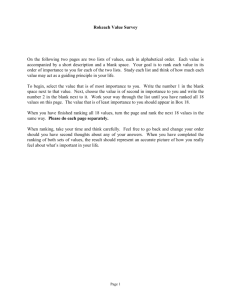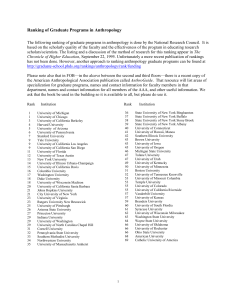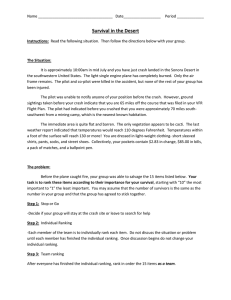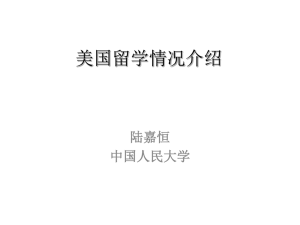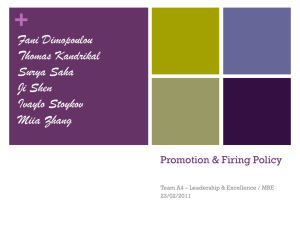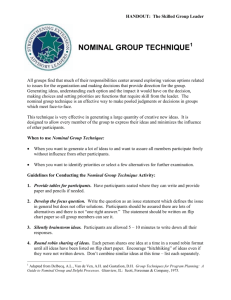Appreciation of the system
advertisement
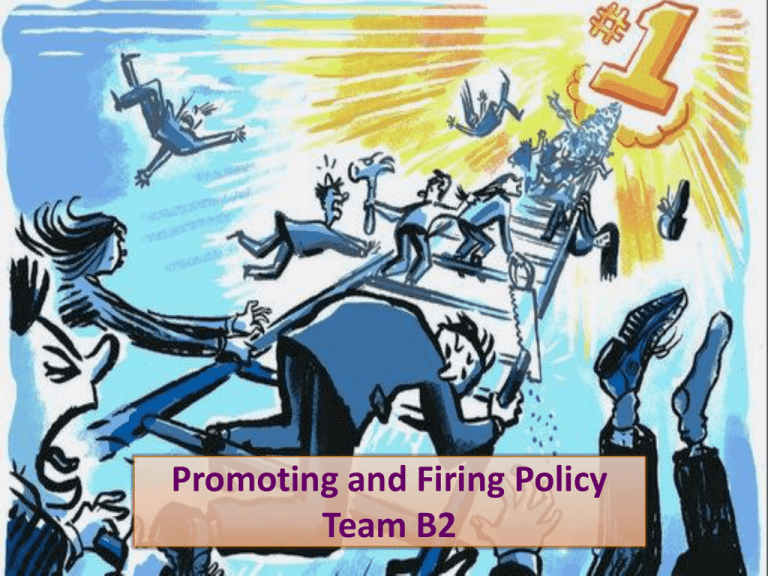
Promoting and Firing Policy Team B2 Contents • • • • • • • • • • • Introduction Names Method Ranking Curves Companies Benefits Deming’s System of Profound Knowledge Deming’s 14 points VS ‘Rank-and-Yank’ General Critique Conclusion References General Electric Ranking Method • Pioneered by Jack Welch in 1990s. • It is described as a ‘major differentiation tool’ to evaluate performance and promotability. • It is an annual process ranking employees according to a 20/70/10 rule. “20/70/10 rule” • This method is known with different names: – Forced Distribution Rating System (FDRS) – Vitality Curve – Differentiation – ‘Rank-and-yank’ – Top Grading Method • The system is based on the premise that an organization has to identify its best and worst employees and reward the top ones with development opportunities and bonuses, whereas encourages the worst performers to leave (Johnson, 2004). • Less effective and capable people can be replaced by new and more capable employees who will ameliorate the overall performance of the workforce (Community Banker, 2005). Ranking Curves It ranks employees according to a curve: 20% stars, 70% acceptable performers, 10% nonperformers (Sedam, 2005). Rewards top 20% in a way that is both personally and financially satisfactory, and develops the 70% with training and coaching, whereas it eliminates bottom performers (Welch, J. and Welch, S., 2006). Companies Benefits GE gained • Set apart the very best from the least effective • Promote the effectiveness of the organization • Facilitate succession planning, pipeline building and leadership development (GE Capital Solutions) • 28x increase in earnings and a 5x increase in revenue at GE between 1981 and 2001. Deming’s System of Profound Knowledge • • • • Appreciation of the System Knowledge about Variation Theory of Knowledge Psychology Appreciation of the system Cases For • Talented team members within the company, thus results in better performances • Increase the average quality of workforce • Motivate employees to work harder Cases Against • Rank-and-yank is weakening the overall organization's system • Discourage teamwork by encourage competition within the organization Knowledge about Variation Cases For • It can be seen that special cause variation (poor performance) is being identified and eliminated from the process • Leads to opportunity for learning which in turn leads to improvement in workforce’s performances Cases Against • Not all people perform in the same way • Performance might be improved after ranking • The recorded values will not be unchanging over time. They will differ and vary. • It’s no individual’s fault that targets weren’t being achieved; it was the system by which they were trying to achieve it Theory of Knowledge Cases For • Improvement requires change • Get rid of 10% lowerperformers so better talent can be brought in • Encourage winning and doing good work Cases Against • Force managers to push out perfectly good employees • Not value teamwork and cooperation • Newly trained employees might be ranked at the bottom 10% Psychology Cases For • People can get motivated and improve their performance • A self-fulfilling prophecy where people behave in a way consistent to how we expect them to behave Cases Against • Considered as a cruel approach • Performance relates to what really motivates people • Respecting the rights of people to obtain joy in work and joy in learning • Discourages the development of strong relationship between employees • Turned into a more political system • False ranking (subjective, bias, favoritism) Deming’s 14 Points VS Rank-and-Yank • Institute training on the job: Employees ought to be given more flexibility and training to improve their skills, as opposed to being fired should their performance falls in the lowest 10th percentile. • Institute leadership: Management's job is NOT to supervise/ evaluate/fire but to institute leadership, whereby focus on the outcome is shifted to focus on understanding and unlocking people's motivation instead. • Drive out fear: Employees fearing that they might not be ranked at the average 70% or top 20% may prevent them from working together effectively. • Eliminate slogans, exhortations, and targets for the workforce: Most poor productivity is caused by the system, and hence, beyond the power of the workers to improve. Framing their performance upon their self-portrait can insult the intelligence of the workers. General Critique • Managers are not qualified to rank employees in the first place (Sedam, 2005) • This method might inflate evaluation in fear of losing team members (Cutler, 2006) • It should be implemented after a stable evaluating process within the organization • The 16% improvement would fall to only 2% after 6 years – It should be deployed in a short-term period with a maximum of 3 years prospect • There are other methods for managing performance and evaluating people Conclusion • Since the 'differentiation' approach yields diminishing return over the years, its unsustainability can result in companies falling behind in terms of creativity and innovation. Workers are discouraged to generate new ideas and try new things because they risk some unsuccessful trials (seen as poor performance) that eventually get them fired (Hughes & Halsal 2010). • SoPK states that most poor productivity is caused by the system. Hence, eliminating the employees does not necessary help eliminating the poor performance. As a matter of fact, an employee may be the scapegoat of the poor system of the company, and if that employee is fired, the company risks losing talent to its competitor. Conclusion • In short, despite proofs from GE’s benefits of the 'differentiation' approach, in the long-run if a company thrives to be sustainably competitive, it should promote learning, eliminate fear from the workforce so employees can actually start concentrating on real improvements, real innovation, sharing of creative ideas; all of which will help retaining talents, reducing costs in training new staff, and possibly lead to higher job satisfaction. • Alternative evaluation methods may include self-assessment, peers-to-peers, etc... SoPK also advocates that performance improvement may be better obtained through a strong program of education and self-improvement. References • • • • • • • Adrian H. & David N. H, (2002): Comparison of the 14 deadly diseases and the business excellence model, Total Quality Management, 13:2, 255-263 Anonymous, (2005a). 'Rank and Yank' Systems May Improve Workforce Performance, Study Finds, Community Banker, 14, 4, p.64. Anonymous, (2005b). 'Rank and yank' benefits work force, Industrial Engineer, 37, 4, p.23. Cost of Firing: Why Employers are Reluctant to Fire Problem Employees, [Online]. URL: http://www.peo7.com/newsletter/newsletter9Issue.htm (Retrieved 4th Feb 2012). Cutler, G. (2006). Tom Tries "Rank-and-Yank" Appraisal, Research Technology Management, 49, 2. p. 58-59. Employee Ranking Systems : Rank and Yank, [Online]. URL: http://performanceappraisals.org/appraisallibrary/Employee_Ranking_Systems/Rank_and_Yank/more2.html (Retrieved 4th Feb 2012) . Johnson, G., (2004). Forced Ranking: The Good, The Bad, And The ALTERNATIVE, Training, 41, 5, p. 24-34. • • • • • • • • Kwoh, L., 'Rank and Yank' Retains Vocal Fans’, The Wall Street Journal [Online]. URL: http://online.wsj.com/article/SB1000142405297020336350457718697006437522 2.html (Retrieved 3rd Feb 2012). MacLennan, A., Forced Ranking Time to dismiss this underperformer?, [Online]. URL: https://www.strategyexecution.co.uk/sites/default/files/articles/forced_ranking.pdf (Retrieved 4th Feb 2012). PRISM Consultancy International, (2001-2005). Dr W. Edwards Deming’s System of Profound Knowledge. Podia Consulting LLC, Forced Ranking: The Controversy Continues, [Online]. URL: http://podiaconsulting.com/pdfs/forced_ranking_the_controversy_continues.pdf (Retrieved 3rd Feb 2012). Sedam, S., (2005). Rank and Yank, Professional Builder, 70, 6, p.33-34 The Organisation as an Organism, [Online]. URL: http://www.e2consulting.co.uk/document/The+Organisation+as+an+Organism (Retrieved 3rd Feb 2012). Vitality curve, GE Capital Solutions, [Online]. URL: http://www.cefcorp.com/commequip/productsandservices/acfc/VitalityCurve.asp (Retrieved 4th Feb 2012). Welch, J. and Welch, S., (2 Oct, 2006). The Case For 20-70-10, Bloomberg Businessweek [Online]. URL: http://performance-appraisals.org/cgibin/links/jump.cgi?ID=10613 (Retrieved 4th Feb 2012). Thank you! Q&A

